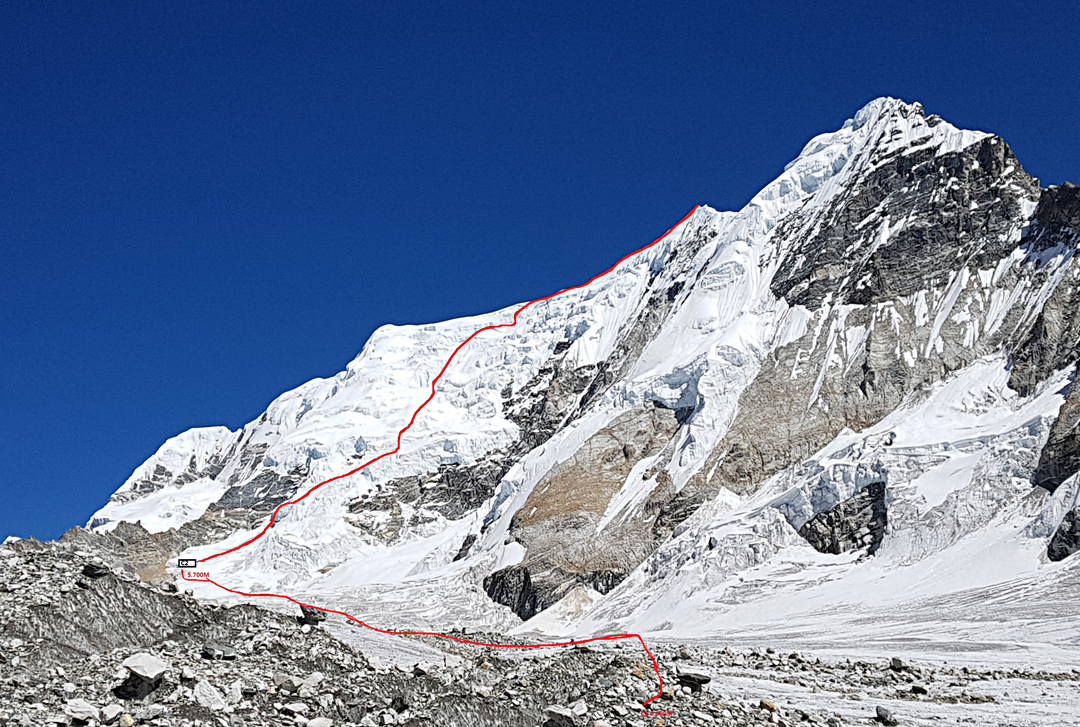Kyungka Ri, Southwest Face and Northwest Ridge, Attempts and Ascent
Nepal, Langtang Himal

During the post-monsoon season there were a number of attempts on Kyungka Ri I (6,599m), an officially unclimbed peak close to the Tibetan border, northeast of Shalbachum, and at least one successful ascent.
First to arrive was a large expedition of six Koreans and four Sherpas (from the Makalu region) led by Yuon Heon-mo. They established base camp on October 11 at 4,700m on the Shalbachum Glacier. Two camps were swiftly made on the southwest face, the highest at 5,700m. At 3 a.m. on the 15th, Oh Min-young, Han San-hum, Dawa Norbu Sherpa, and Pasang Norbu Sherpa left the high camp and climbed up to the northwest ridge, negotiating a wide crevasse, where they had to climb down 10m and out the other side. Between 10 and 10:30 a.m., all four claim to have reached the summit. Four hundred meters of rope were fixed during the ascent. However, while their summit photos are certainly from the upper northwest ridge, they obviously are taken on relatively wide and flat ground, whereas the summit is very sharp.
Rather later in the season came a Japanese expedition led by Yoshichika Yamada, making his third attempt. His first took place from March 18–April 12, 2010, and with him were Hisayuki Akada, Takeshi Hirata, and Masanori Mori. They established base camp on the Shalbachum Glacier at 4,400m, but were then plagued with heavy snowfall. Their plan was to climb the southwest face to northwest ridge, and in this they managed to establish Camp 2 at 5,850m. Unfortunately, this camp became their high point and they withdrew in bad weather. A second attempt was made from November 6–December 8, 2011, by Mori, Masao Toyada, and Yamada, but these three were stopped by an unexpectedly large crevasse at 6,100m.
Yamada's third attempt took place via the same route from November 8–December 10, 2017. This time Yamada's partners were Yuki Shibata and Yu Yamamoto. This party discovered the glacial retreat to be astonishing since Yamada's previous visit. They had expected snow and had brought many snow stakes but very few ice screws, and the route to the ridge was completely on ice, forcing them to retreat from 5,800m. The Japanese were unaware of the Korean expedition around two months earlier.
The true summit was definitely reached shortly after the Korean expedition, and via the same route, by a solitary climber who believes the Korean “summit” photos were most likely taken at the flat section of ridge about 200m to 300m away and 40 to 50 vertical meters below the top. At this point, the solo climber saw that an obvious line of blown-in footprints leading up the ridge appeared to stop, though at the time this was not thought significant, as the snow from there to the summit was firmer and more wind-scoured. The Korean team later said that they took the photos a little lower than the summit because the latter was so sharp.
Lindsay Griffin, with help from Oh Young-hoon, Korea, and Yu Yamamoto, Azumino Climbing Club, Japan



